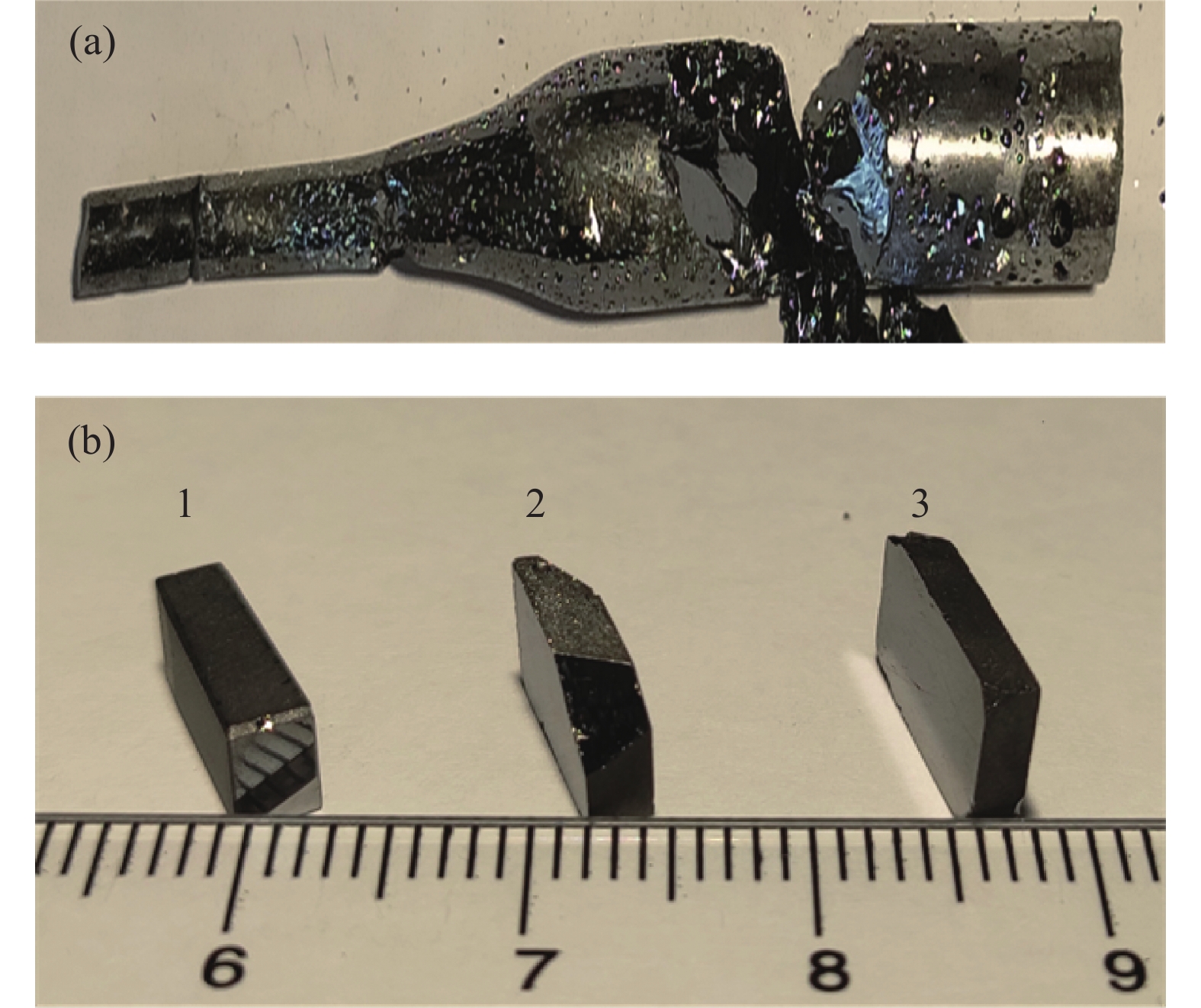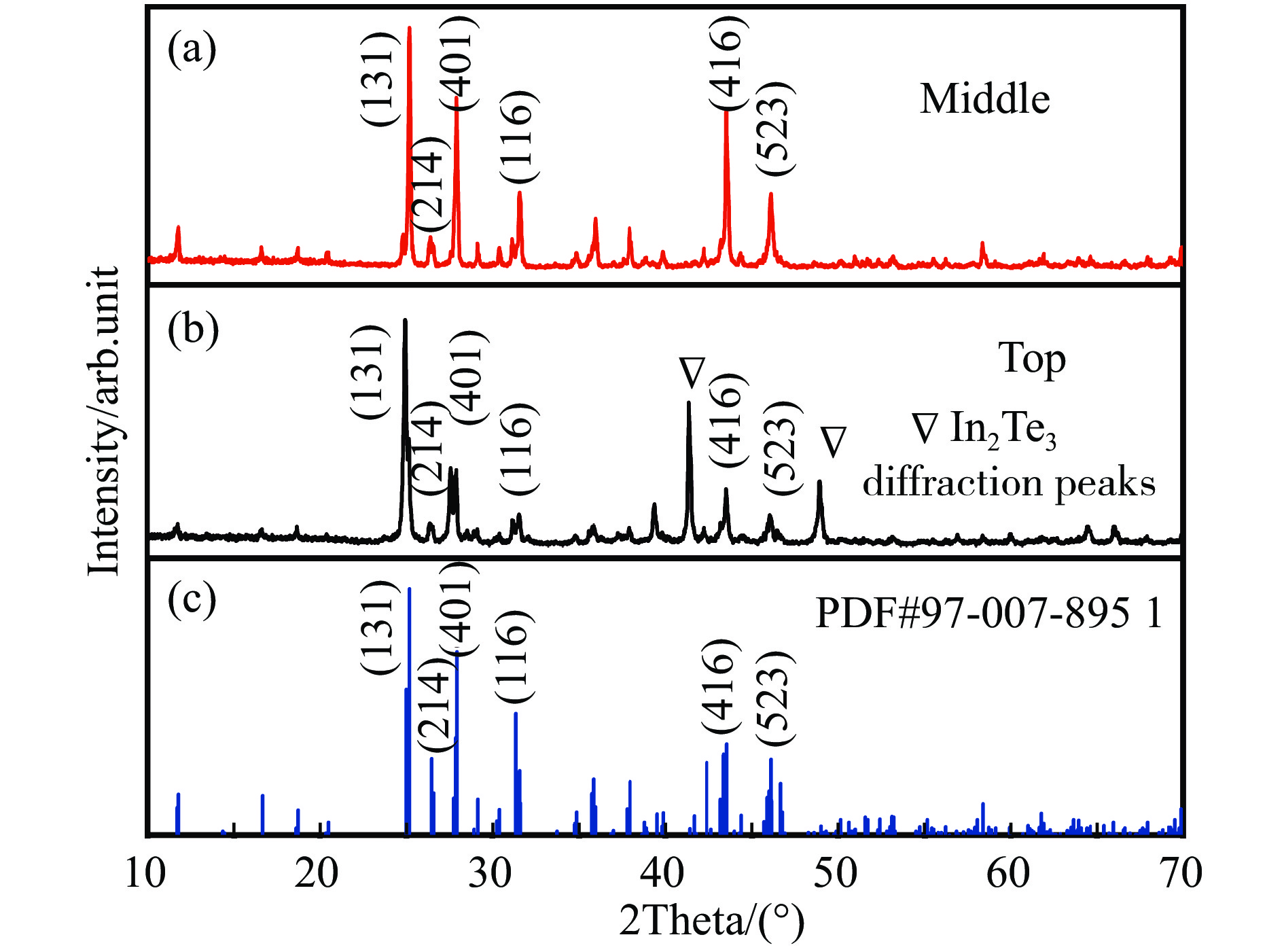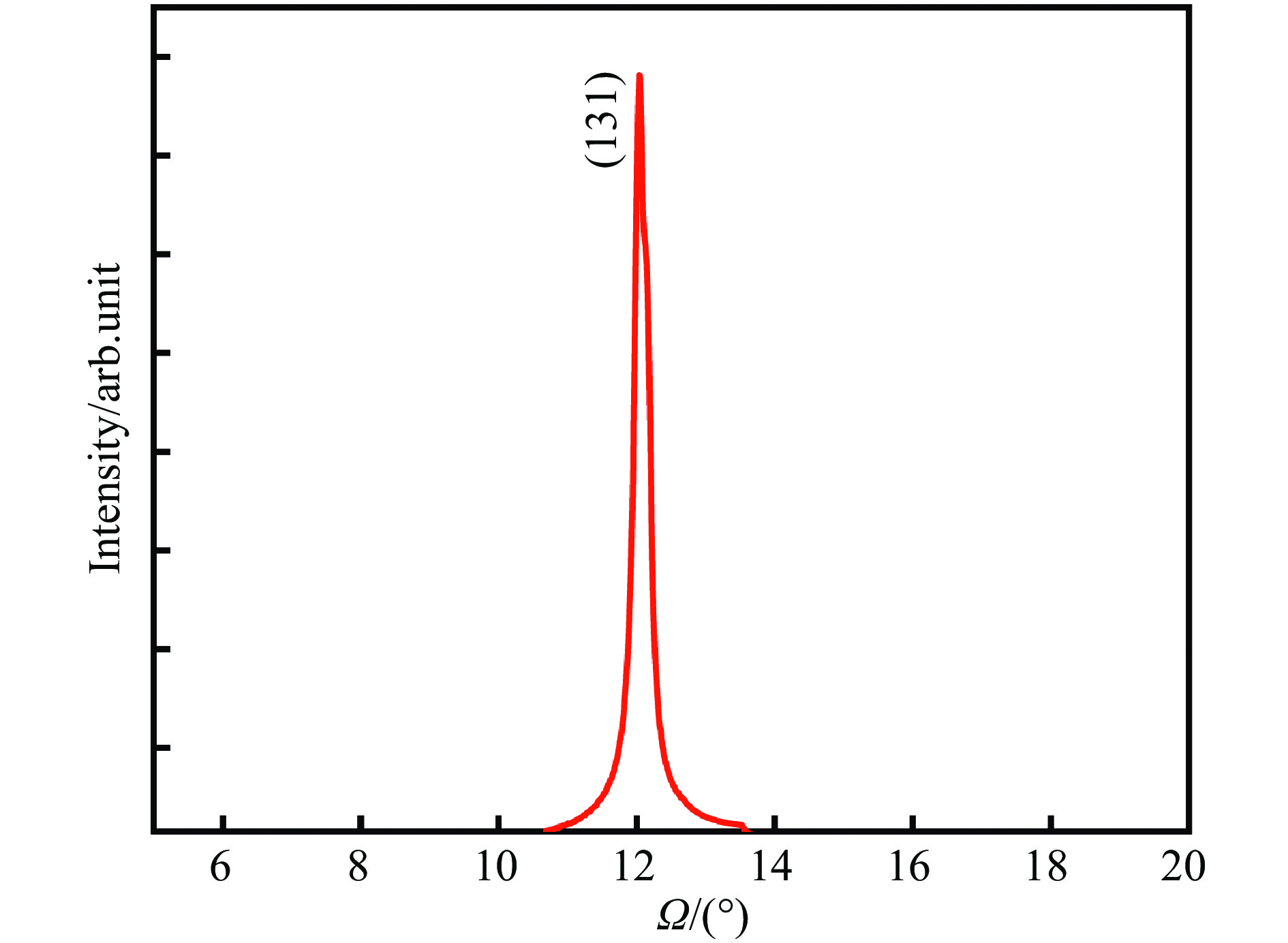-
非线性光学技术可将成熟波段的激光拓展至新的波段,实现中、远红外乃至太赫兹激光的连续调谐输出,红外非线性光学晶体是该激光频率转换系统的核心材料[1-3]。ZnGeP2、AgGaS2等商业化晶体已在中红外(3~5 μm)波段得到广泛应用;AgGaSe2、CdGeAs2、CdSe、BaGa4Se7等晶体在远红外(8~14 μm)波段具有较大的应用潜力[4]。将红外激光拓宽至更长的波段,在红外光谱、激光技术等众多领域同样具有重要的应用[5][6]。然而,目前受限于晶体的透光范围,在14~25 μm乃至25 μm以上波段,合适的非线性光学晶体十分匮乏。
相对于磷、硫、硒化物晶体,碲化物晶体具有较低的声子能量,其在长波波段具有更宽的透光范围。三元碲化物PbIn6Te10是一种新型非线性光学材料[7][8],正单轴晶体,属于三方晶系,空间群为R32,其熔点约为630 ℃,禁带宽度Eg=0.96 eV,它的透光波段宽(1.3~31 μm),双折射适宜(~0.05),可通过2.79 μm激光器泵浦OPO,获得5~25 μm甚至太赫兹波段连续调谐光源输出,此外,它还具有非线性系数大(d11=51 pm/V)、机械性能好、稳定性高等优点。俄罗斯[8]、捷克[9]等国科研工作者都在积极开展PbIn6Te10晶体的研制。目前已初步实现尺寸为φ12 mm×30 mm的晶体生长,A. A. IONIN[10]等人计算了PbIn6Te10晶体相关非线性性能,表明晶体具有实现10~30 μm调谐激光输出的能力。国内目前暂无该晶体的相关文献报道。
鉴于PbIn6Te10晶体具有的优良品质以及可能的后续应用,笔者所在课题组积极开展了该晶体的探索研究。相图表明,PbIn6Te10晶体为非同成分熔融共熔体,晶体生长过程熔体组分难控制,前期按化学计量比配比,做了大量的实验工作,发现晶体生长难度大,进展缓慢。因此,寻找合适的组分配比是生长PbIn6Te10优质单晶的关键。目前,实验室通过多次实验摸索出较合适的组分配比参数,单温区法合成多晶原料,垂直布里奇曼法已生长出较大尺寸PbIn6Te10单晶,并对晶体的结构、光学透过率等性能进行了测试。
-
优质的多晶原料是生长高品质单晶的前提,相比于磷、硫等活泼化学组分,碲组分高温条件下具有较小的饱和蒸气压,因此,可采用单温区法高温直接进行PbIn6Te10多晶原料的合成。这里需要注意两点:(1) Pb在空气中易氧化,氧污染可能会导致后续生长的晶体形成点缺陷、位错等多种缺陷,降低晶体光学性能。通常在手套箱中称取原料,减少Pb与空气接触的时间;(2)做为非同成分熔融化合物,按化学计量比配比,合成的原料很难实现晶体的生长。通过研究PbTe和In2Te3相图以及实际的生长经验,文中偏向于称取适量过量的In2Te3。具体步骤如下。
按PbIn6Te10化学计量比分别称取高纯In(6N)、Te(6N)、Pb(6N)原料共200 g,再按In2Te3化学计量比称取高纯In(6N)、Te(6N)原料20 g左右,混合装入清洗后并经过镀碳工艺处理的圆柱形石英坩埚,将坩埚抽真空至1×10−3 Pa,以氢氧焰封结。将封结好的坩埚放入实验室自行设计制备的单温区多晶合成炉中,设定控温程序,将炉体以约30 ℃/h匀速升温至650 ℃,后恒温40 h,恒温期摇晃合成炉数次,让原料充分反应,恒温结束后,合成炉按20 ℃/h匀速,缓慢降至室温。
合成好的多晶锭如图1所示,晶锭表面呈银灰色,致密无孔,闪现出银色的金属光泽。
-
起初由于缺少合适尺寸、方向的籽晶进行PbIn6Te10晶体生长,实验室采取了多次自发成核的方式进行,发现生长难度较大。后续基于自发成核的结晶数据,同时筛选其中的小块优质单晶,采用了籽晶定向的布里奇曼法进行进行PbIn6Te10晶体的生长。生长炉及温场示意图如图2所示。
选取优质的籽晶,将适量的多晶料研磨后装入镀有碳膜的设计好的石英坩埚,抽真空至1×10−3 Pa,用氢氧焰封结,再用石英管真空密封一次,随后将坩埚放入竖式布里奇曼炉中进行生长。炉体为两段独立加热系统,坩埚放置于两段炉体衔接处。生长初期,以30 ℃/h均速将炉体升温,上炉升温至690 ℃,下炉升温至540 ℃,恒温20 h左右,确保晶体籽晶以上部分全部熔化;随后将上下炉体同时以10 ℃/h缓慢降温100 ℃左右,将原料过冷,恒温10 h左右后,再次将上下炉体同时以30 ℃/h均速升温100 ℃,恒温数小时后,将下炉温度缓慢升高,确保籽晶部分熔化又不全部熔化。最终控制上炉温度在680~690 ℃,下炉温度530~540 ℃,生长温度梯度约为7~10 ℃/cm。进行生长时,通过Pt-Ph热偶实时监测坩埚底部温度,控制炉体以约为0.2 mm/h的速度上升,生长结束后,以10 ℃/h匀速降温至室温。生长出的单晶如图3(a)所示,晶体截面光滑致密,外观呈现出亮银色,尺寸约φ11 mm×55 mm。晶体出现断裂,其原因可能有多种:如晶体各项异性较大、生长时降温速度过快,或者是生长结束时拿取晶体动作幅度较大。后续笔者等将继续开展这方面的研究,希望得到完整的较大尺寸单晶棒。初步加工的单晶测试片如图3(b)所示,其中1号与2号样品(厚度约为2.5 mm,截面5.5 mm×9.5 mm)是加工的单晶薄片,3号为(131)定向样品(截面约6.5 mm×11.5 mm,厚度约2 mm)。
-
PbIn6Te10晶体生长难度较大,影响因素也较多。下面主要从以下两点探讨。
(1)特殊的晶体生长组分控制。PbIn6Te10相图显示[11],它的固溶体范围很大,从70%的In2Te3、30%的PbTe至83%的In2Te3、17%的PbTe。不同的PbTe与In2Te3组分比例对晶体的生长影响很大,甚至难以生长出晶体。合适的组分比例对生长高品质单晶尤为重要,实验室进行了PbTe与In2Te3多种组分比例配比生长,发现大部分情况下长出的晶体质量较差,光学透过率低。通过深入研究PbTe与In2Te3相图,发现适量偏向In2Te3方向可能有助于PbIn6Te10晶体的生长,通过多次的实验摸索,并对不同的实验配比结果进行检测,最终寻找到一个较适合的适合PbIn6Te10单晶生长的组分配比(In2Te3过量10%左右)。
(2)合适的籽晶熔接温度及梯度控制。优质的籽晶是生长高品质晶体的一个重要影响因素,籽晶熔接温度控制是这一过程的关键,需要长期的实验积累和经验总结。另外,合适的温度梯度选择和稳定的温度梯度维持也非常重要,从维持结晶界面的角度考虑,通常希望温度梯度较大,但过大的温度梯度可能会导致晶体内结晶质量较差。此外,在晶体生长之前,对熔体进行降温过冷,再升温使原料熔融,多次反复操作降低了多晶核结晶的可能,并在此基础上进行籽晶熔接,效果较好。
-
为确认生长的晶体成分及结构,从图2单晶棒中部、顶部取少量单晶研磨成粉末,采用丹东DX-2700X射线衍射仪(扫描速率0.05°·s−1,λ=0.154 06 nm,扫描范围10°~70°),进行XRD测试。图4(a)为中部单晶的粉末衍射图,与标准图谱(PDF#97-007-8951)对比发现,所有衍射峰都可指标为三方结构的PbIn6Te10,峰位与标准图谱完全吻合,没有其他杂峰出现,峰较强,结晶度较高。依据所得的测试数据,计算出的晶格参数为:a=1.496 1 nm,c=1.825 7 nm,与参考文献[6]报道的也非常相近。图4(b)为顶部单晶的衍射图谱,可以看出,出现了In2Te3杂质衍射峰,这可能是生长结束后过量的In2Te3有自动排杂至熔体顶部导致。
-
为检测生长的单晶结晶质量,从生长的晶体棒上中部切割、加工出(131)单晶样品。采用荷兰PANalytical公司的X'PertX射线衍射仪(ω扫描模式)对图3(b)中3号样品进行摇摆曲线测试,测试结果如图5所示,晶面摇摆曲线峰形尖锐,对称性较好,半高宽(FHWM)约0.253°,结晶质量较好,后续将计划降低生长速度,看能否对结晶质量进一步提升、改善。
-
为了检验生长出的单晶在红外波段的透过率,采用两种仪器进行了不同波段的测试,包括美国Midwest公司Lam950型紫外可见近红外分光光度计(范围1~2.5 μm)和德国Bruker公司Vertex 70型傅里叶红外光谱仪(范围2.5~25 μm)。图3(b)中2号样品测试的透过率曲线如图6(a)所示(其中黑线为理论透过极限,蓝线与红线分别代表两台不同范围仪器测得的数据),晶体的截止透光波段约1300 nm(见图6(a)插图),在1.7~25 μm波段具有较高的透过率,在2.5~25 μm波段透过率在50%以上,波动较小。另外,值得注意的是,由于受到仪器测试范围的限制,长波段截止到25 μm,但PbIn6Te10透过率没有显示出下降趋势,也验证了晶体的长波的透光波段非常宽广。
利用下式,进行了晶体吸收系数α[12]的计算:
式中:T为所测晶体透过率;L为晶体厚度;R为入射光垂直通过界面的反射率(
$R = \dfrac{{{{\left( {n - 1} \right)}^2}}}{{{{\left( {n + 1} \right)}^2}}}$ ,n为晶体折射率[13])。计算的吸收系数α如图6(b)所示,2.5~25 μm波段吸收系数处于0.3~0.6 cm−1之间,后续将进行退火实验,探索能否实现晶体吸收系数的降低。 -
宽广的透光波段(1.3~31 μm)、大的非线性系数(d11=51 pm/V)和适宜的双折射(~0.05),这些优点使PbIn6Te10晶体成为非常具有研究价值的新型长波非线性材料。文中对PbIn6Te10的生长进行了初步的研究,通过探索并筛选出较合适的PbTe与In2Te3组分配比,利用坩埚下降法生长出尺寸为φ11 mm×55 mm单晶棒。XRD粉末衍射、单晶摇摆、透过率等测试表明,生长出的单晶质量尚可,半高宽(FHWM)约0.253°,在2.5~25 μm波段,晶体的红外透过率50%以上,对应收系数处于0.3~0.6 cm−1之间。后续将继续优化组分配比及生长参数,实现更大尺寸、更高品质的单晶生长。
Growth of the new long-wave infrared nonlinear crystal PbIn6Te10
doi: 10.3788/IRLA202049.0418001
- Received Date: 2019-12-19
- Rev Recd Date: 2020-01-23
- Publish Date: 2020-04-24
-
Key words:
- nonlinear optical crystal /
- PbIn6Te10 crystal /
- crystal growth /
- Bridgman method /
- long-wave infrared (LWIR)
Abstract: The new far-IR nonlinear crystal material PbIn6Te10 has great application potential among 14-25 μm even more than 25 μm because of its special optical properties, including clear transparency(1.3-31 μm), large nonlinear coefficient(d11=51 pm/V) and suitable birefringence(~0.05). The phase diagram analysis combined with the experiment was used to select the appropriate group distribution ratio, the PbIn6Te10 polycrystal was synthesized by high temperature single-temperature zone method(STZM), and single crystal with size of



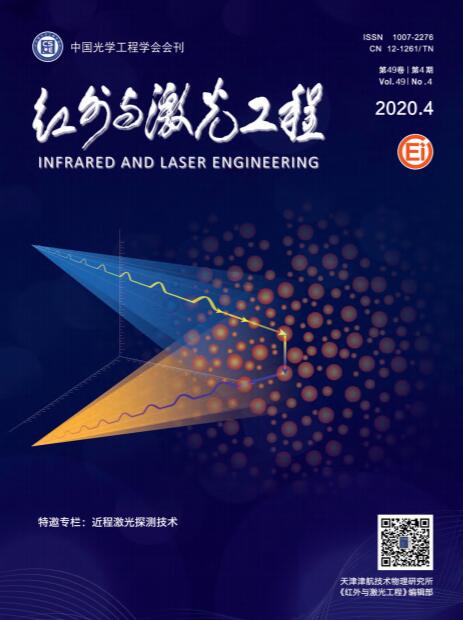








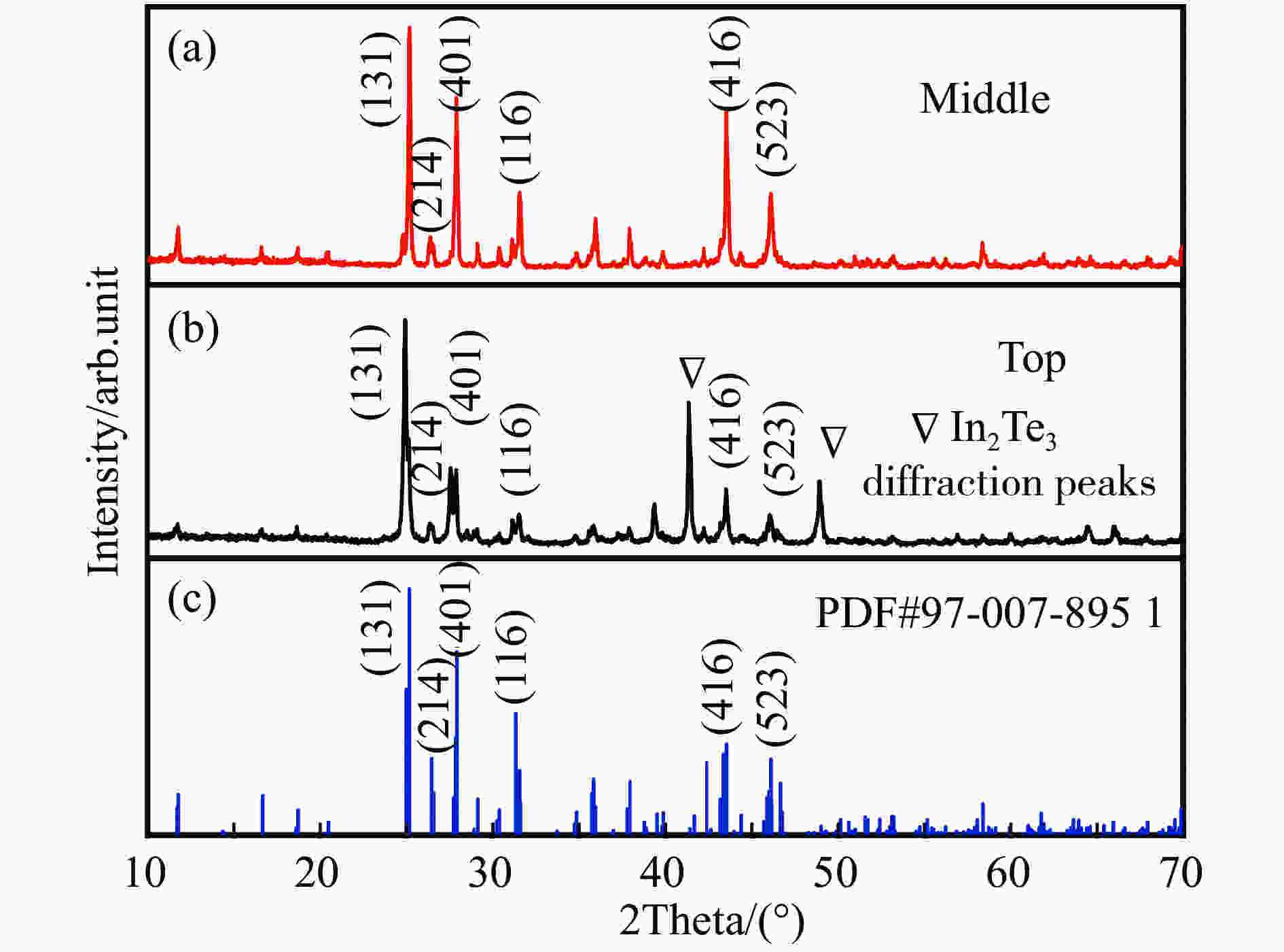


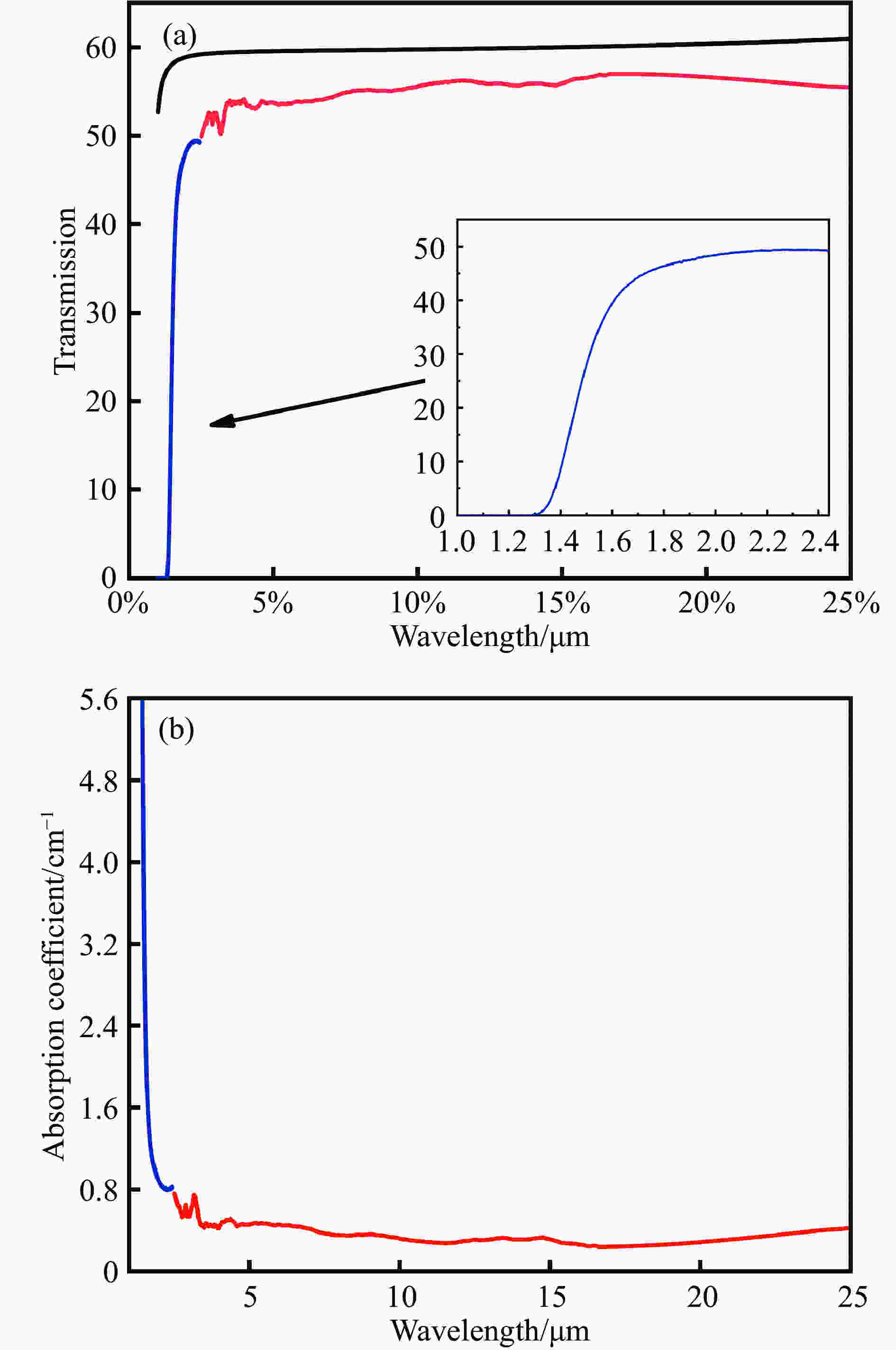

 DownLoad:
DownLoad:

